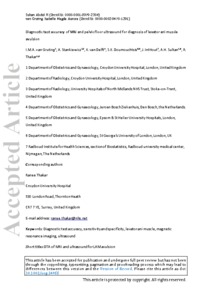van Gruting, IMA; Stankiewicz, A; van Delft, K; Doumouchtsis, SK; Inthout, J; Sultan, AH; Thakar, R
(2022)
Diagnostic test accuracy of magnetic resonance imaging and pelvic floor ultrasound for diagnosis of levator ani muscle avulsion.
Ultrasound Obstet Gynecol, 60 (4).
pp. 559-569.
ISSN 1469-0705
https://doi.org/10.1002/uog.24955
SGUL Authors: Sultan, Abdul Hameed
![[img]](https://openaccess.sgul.ac.uk/114486/1.hassmallThumbnailVersion/Ultrasound%20in%20Obstet%20Gyne%20-%202022%20-%20van%20Gruting%20-%20Diagnostic%20test%20accuracy%20of%20MRI%20and%20pelvic%20floor%20ultrasound%20for.pdf)  Preview |
|
PDF
Accepted Version
Available under License ["licenses_description_publisher" not defined].
Download (961kB)
| Preview
|
Abstract
Objective
To estimate the diagnostic test accuracy of magnetic resonance imaging (MRI) and pelvic floor ultrasound for levator ani muscle (LAM) avulsion in a general parous population, with view to establishing if ultrasound could substitute for MRI to diagnose LAM avulsion.
Methods
This was a cross-sectional study of 135 women 4 years after their first delivery. Signs and symptoms of pelvic floor dysfunction were assessed using validated methods. All women underwent four-dimensional transperineal ultrasound (TPUS), three-dimensional endovaginal ultrasound (EVUS) and MRI. Images were acquired at rest, on pelvic floor muscle contraction (PFMC) and on maximum Valsalva maneuver, and analyzed by two blinded observers. Predefined cut-off values were used to diagnose LAM avulsion. In the absence of a reference standard, latent class analysis (LCA) was used to establish diagnostic test characteristics for LAM avulsion as the primary outcome measure. Secondary outcomes were kappa (κ) agreement between imaging techniques, intraclass correlation coefficients (ICC) for hiatal measurements at rest, on PFMC and on maximum Valsalva maneuver, and the association of LAM avulsion with signs and symptoms of pelvic floor dysfunction.
Results
The prevalence of LAM avulsion was 23.0% for MRI, 11.1% for TPUS and 17.8% for EVUS. The prevalence of LAM avulsion using LCA was 15.7%. The sensitivity for LAM avulsion of TPUS (71% (95% CI, 50–90%)) and EVUS (91% (95% CI, 74–100%)) was lower than that of MRI (100% (95% CI, 84–100%)). The specificity of TPUS (100% (95% CI, 97–100%)) and EVUS (95% (95% CI, 91–99%)) was higher than that of MRI (91% (95% CI, 85–97%)). MRI and EVUS had high predictive values for the assessment of major LAM avulsion (positive predictive value (PPV), 95% and negative predictive value (NPV), 100%; PPV, 100% and NPV, 98%, respectively), while TPUS had high predictive values for minor LAM avulsion (PPV, 100% and NPV, 95%). Major LAM avulsion on MRI and EVUS was associated with anterior vaginal wall prolapse, which was not found for TPUS. The agreement in the diagnosis of LAM avulsion (κ, 0.69) and hiatal measurements (ICC, 0.60–0.81) was highest between MRI and EVUS.
Conclusions
Pelvic floor ultrasound can be implemented as a triage test to assess parous women for LAM avulsion because of its high specificity. Ultrasound cannot substitute for MRI because of its lower sensitivity. The predictive ability of ultrasound is moderate for the presence, and very good for the absence, of LAM avulsion. A positive test should be confirmed by a different observer or imaging technique.
| Item Type: |
Article
|
| Additional Information: |
This is the peer reviewed version of the following article: Van Gruting, I.M.A., Stankiewicz, A., Van Delft, K.W.M., Doumouchtsis, S.K., Inthout, J., Sultan, A.H. and Thakar, R. (2022), Diagnostic test accuracy of magnetic resonance imaging and pelvic floor ultrasound for diagnosis of levator ani muscle avulsion. Ultrasound Obstet Gynecol, 60: 559-569, which has been published in final form at https://doi.org/10.1002/uog.24955. This article may be used for non-commercial purposes in accordance with Wiley Terms and Conditions for Use of Self-Archived Versions. This article may not be enhanced, enriched or otherwise transformed into a derivative work, without express permission from Wiley or by statutory rights under applicable legislation. Copyright notices must not be removed, obscured or modified. The article must be linked to Wiley’s version of record on Wiley Online Library and any embedding, framing or otherwise making available the article or pages thereof by third parties from platforms, services and websites other than Wiley Online Library must be prohibited. |
| Keywords: |
Diagnostic test accuracy, levator ani muscle, magnetic resonance imaging, sensitivity and specificity, ultrasound, 1114 Paediatrics and Reproductive Medicine, Obstetrics & Reproductive Medicine |
| SGUL Research Institute / Research Centre: |
Academic Structure > Institute of Medical & Biomedical Education (IMBE) |
| Journal or Publication Title: |
Ultrasound Obstet Gynecol |
| ISSN: |
1469-0705 |
| Language: |
eng |
| Dates: |
| Date | Event |
|---|
| 2 October 2022 | Published | | 28 May 2022 | Published Online | | 19 May 2022 | Accepted |
|
| Publisher License: |
Publisher's own licence |
| PubMed ID: |
35633511 |
 |
Go to PubMed abstract |
| URI: |
https://openaccess.sgul.ac.uk/id/eprint/114486 |
| Publisher's version: |
https://doi.org/10.1002/uog.24955 |
Statistics
Item downloaded times since 30 Jun 2022.
Actions (login required)
 |
Edit Item |



